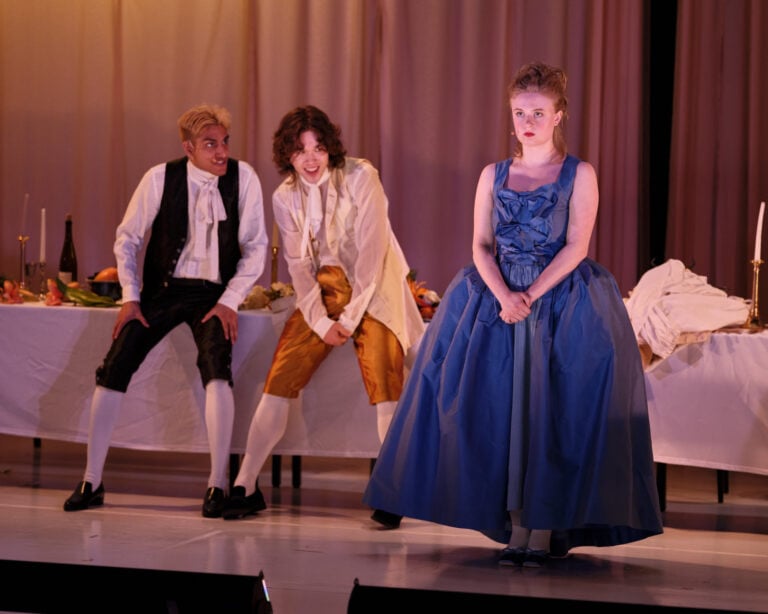As a venue, Shanley Pavilion is far from perfect: it doesn’t fit many people, large wooden poles obstruct the view at some angles and there aren’t many places for actors to enter and exit the stage without being seen.
In spite of these limitations – or, perhaps, because of them – no two sets in the black box theater are the same. Almost every week, a new student production team transforms the barren and dusty interior to fit the needs of their show. WAVE Productions’ “Sunday in the Park with George,” which ran Nov. 10 and 11, was no exception. The production was a masterpiece, every design and performance element mixed in harmony.
Scenic designer and Communication junior Sam Webster crafted a literal canvas on Shanley’s blank canvas for the show’s set. Intersecting angular white frames and a multi-level platform became a blank page for not only George Seurat’s (Communication junior Eli Blanks) artistry, but also the goings-on of the characters who visit the park on Sundays. The set’s jutting forms evoke movement – even when empty, the stage feels action-packed. Large paper trees and bushes are attached and removed from the white frames throughout the show, adding to that sense of movement.
Communication junior Hayley Chisholm’s colorful lighting wonderfully complements the set, especially when representing Seurat’s palette. In one number, as Seurat perfects his pointillist technique, circles of light shine on the stage floor and he chooses colors from his palette.
The first act of the show follows Seurat as he compiles sketches for his painting, “A Sunday on La Grande Jatte.” We meet the various park goers and their daily grievances. Right away the audience is given a look into the artist’s pursuit of permanence and their unrelenting work ethic, which pushes him away from his loved ones.
Seurat is portrayed as a man obsessed with permanence and revolted by stagnance. While sketching his mistress, Dot (played by Communication senior Anna Rosenthal with an ebullient charm), he is unconcerned with her physical discomfort as she sweats in the sun. And yet, his peers criticize him for a change in technique and a focus on common people in his paintings.
With another actor, it may have been easy to despise the painter. Blanks, however, approaches the role with an incredible sincerity, allowing us to sympathize with the painter’s ambitions. His dexterity as an actor is especially prominent in “The Dog Song,” he shifts between gravelly and shrill affects as Seurat imagines the thoughts of the two dogs he is sketching.
Every member of the cast showed incredible dedication to their roles, bringing color and energy to the blank canvas of the set. Many, including Blanks, also acted in “John Proctor is the Villain,” which ran earlier this fall.
The most stunning visual of the production was the creation of tableau vivant at the end of the first act, in which the parkgoers moved to their places in Seurat’s famous painting. Blanks stands on a seat in the audience, raising his arms out with his fingers in the shape of a frame, observing his final product.
In the second half of the show, the chatty Sundays of 1884 are long gone, and we are transported to an art museum in the 1980s. The white set, once a space of opportunity, now has a cold quality. Blanks plays 39-year-old George, a sculptor encumbered by the empty pleasantries of the modern art world and the monotony of his work. His grandmother Marie, played by Rosenthal, is the daughter of Dot and George Seurat and joins him at the opening of his latest piece, “Chromalume #7.”
Rosenthal transforms herself completely in this half, putting on a soft and frail voice even as she sings. Twentieth century George ventures to the island of La Grande Jatte to present his light sculpture. In the process, he connects with his long-dead family members, and finds the courage to experiment in art again.
“Sunday in the Park with George” is a beautiful ode to art and everyday life. Songwriter Stephen Sondheim presents many vocal challenges in the music, which the cast handled with ease. It’s a show I would watch a thousand times again if I could.
Email: [email protected]
Twitter: @jahariia
Related Stories:
— WAVE Productions’ ‘Fun Home’ centers identity, queerness and family
— Witches will take center stage in WAVE Productions’ ‘Macbeth’
— WAVE Productions’ “She Kills Monsters” explores grief and sister relationships


























